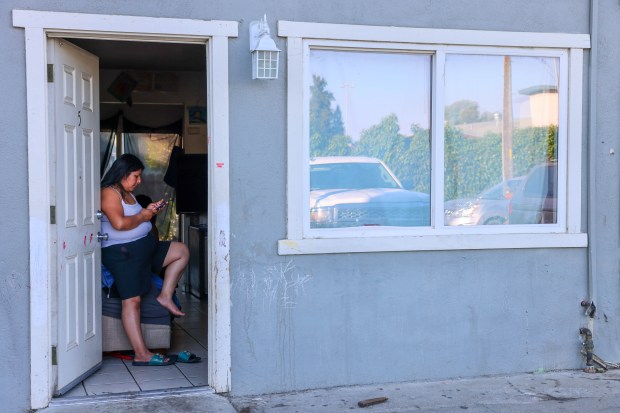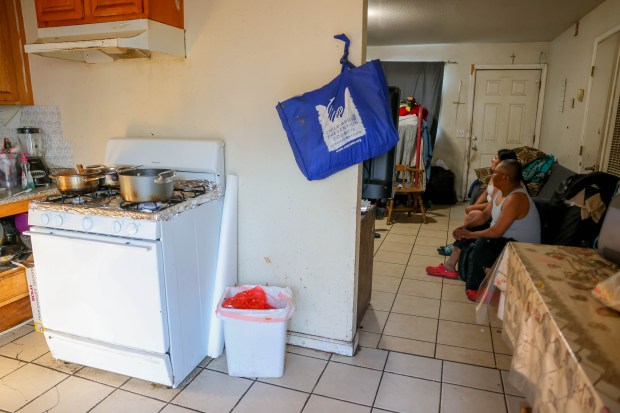GILROY — In the modest Gilroy two-bedroom home that farmworker Jesusita Ortiz shares with her family, the living room doubles as a storage space and a shared bedroom for her children, complete with a bunk bed and colorful anime posters lining the walls. The compact set up is a necessary arrangement for the growing family — nine in all, with a grandchild on the way.
For at least 15 years, Ortiz has had to deal with the crowded space — along with a broken fridge, roaches, bedbugs and unresponsive landlords. She desperately wishes she could afford a better place for her and her family, but larger options are out of reach.
“We work — sometimes 12, 13 hours (a day) — but it still isn’t enough,” said Ortiz in Spanish, who lives with her husband Rodolfo Robles. “I tell the kids that we need a bigger space because my daughter is 15 now, she needs her own room. It’s really hard for us to live like this, but we need to work in the fields because it’s what we know.”
Ortiz’s plight reflects the dramatic shortage of farmworker housing in Santa Clara County — a difficult situation that has forced many to live in substandard conditions, from overcrowding to homelessness.

Now, a new state bill seeks to alleviate the crisis by making it easier to build dedicated housing for farmworkers in Santa Clara and Santa Cruz counties. While advocates acknowledge the bill is only a small step, they say its passage could be key to improving housing conditions for farmworkers like Ortiz.
“Our ag workers are up at the crack of dawn doing this incredible labor to make sure we have food in our homes,” said Gail Pellerin, the California Assembly member who represents parts of Santa Clara and Santa Cruz counties and is sponsoring the bill. “(Farmworkers) need to have a good place to go home at night, to rest their heads and raise their families. So we need to do everything we can to make sure that we are building housing for these folks.”
The bill, AB 3035, would streamline approval to allow developers to build up to 150 units of farmworker housing on land within 15 miles of grazing or farmland. Pellerin credits the idea to Santa Clara County Supervisor Sylvia Arenas, who represents southern Santa Clara County and has helped lead a push for more farmworker housing in the county.
“Providing safe and healthy and affordable housing for agricultural workers is a top priority for our county,” said Arenas while testifying in support of the bill at the California Assembly this April, noting that the issue struck a personal note as the daughter of a bracero farmworker who toiled in the fields. “For far too long, this issue has been allowed to languish.”

In 2018, Santa Clara County determined that it needed 700 more units of housing to meet the needs of year-round farmers, and 1,400 units for migrant farmers.
But in recent years, the county has only approved 62 new units dedicated for farmworkers, almost all of which is set aside within affordable housing developments, and in 2020 the county planning commission approved the renovation of five buildings meant to house 200 seasonal workers.
The housing shortage is reflected in the dire conditions of many farmworkers. Interviews with several advocates throughout Santa Clara County revealed a wide range of desperate living conditions beyond crowded housing — with farmworkers living in abandoned buildings, shipping containers, sheds — or simply left unsheltered. In all of these situations, the farmworkers, many of whom live on the farms where they work, refused to be interviewed for fear of being fired or losing their housing.
Ana Mendoza, who works with farmworkers as part of the Community Agency for Resources, Advocacy and Services in Gilroy, recalls one family who lived in a rusted shipping container on the farm where they worked. While she helped them move into a hotel and was building a legal case against the farmer, the family decided to return to the farm.
“They just decided to drop (the case). They were so afraid to do anything against their landlord-slash-boss,” said Mendoza. “When you are so low-wage, there is so much fear of not having enough money to live.”

Though previous bills have tried to alleviate the housing scarcity, they have fallen short. In 2019, a state law called the Farmworker Housing Act eased zoning laws to allow developers to build housing on agricultural land, but it had virtually no effect in Santa Clara County. While the COVID-19 pandemic factored into the slow uptake, advocates soon realized that sewage and water were far too expensive to run out to farms for small projects. Additionally, the rural developments involved a labyrinth of agency and governmental entities to give their approval — a painstaking process that Arenas’ Policy Director Patrick McGarrity likened to “a Rubik’s cube in a tangled knot.”
The new bill hopes to cut through the Gordian Knot, or at least make a notch, by expanding the scope of the 2019 bill in Santa Cruz and Santa Clara County. By allowing projects up to 15 miles away from farmland, the bill would permit developments to move closer to nearby municipalities so that they could more readily tap in to existing water and sewage, skirting around the logistical quagmire that bogs down potential rural projects. The expanded cap from 36 to 150 units is meant to make it more cost-effective to build.
The bill passed the Assembly with no opposition and is on track for a vote on the Senate floor in late August. If the Senate passes the bill, it will go into effect in January 2025.
Still, the bill has several key limitations. For one, it doesn’t allocate any funding for developments, meaning many developers would need to turn to local, federal or private sources to build. “There really aren’t that many resources dedicated to create farmworker housing,” said Matt Huerta, an affordable housing consultant based in Monterey County. “We can have a great project — it’s designed, entitled, the infrastructure is there — but then we’re waiting around for funding.”
Though most farmworkers in the state are immigrants, the housing would not be eligible for state funding if it included certain visa holders, according to Pellerin’s office. And while federal money supports most affordable developments, families don’t qualify for federally-supported housing if their head of household is undocumented, said Huerta.

Despite these shortcomings, advocates assert that the bill is a crucial step forward, and Huerta argues that anything that increases housing supply ultimately will help farmworkers, no matter their documentation status. “(Farmworker families) stand a much better chance to have a roof over their head if there’s just flat out more housing production,” he said.
In addition to supporting the bill, the county has dedicated over $1.2 million for a wide-ranging plan to improve farmworker housing — adding a dedicated position to help builders with permitting and working on ideas ranging from grant programs and fee waivers to designating county land for farmworker housing. “Each is only a piece of the puzzle,” McGarrity said.
Even now, though, those puzzle pieces are offering a glimmer of hope for Ortiz, her husband and their children as they search for a better life. Together, they have applied for one of the 30 units dedicated for farmworkers at Morgan Hill’s Royal Oaks Village housing development. There, Ortiz dreams of “a dignified living space” — one that is safe, has enough room for her children, and is “a good space where I can have my things, a little table where I can concentrate … where I can have a space of my own.”
Source: www.mercurynews.com
